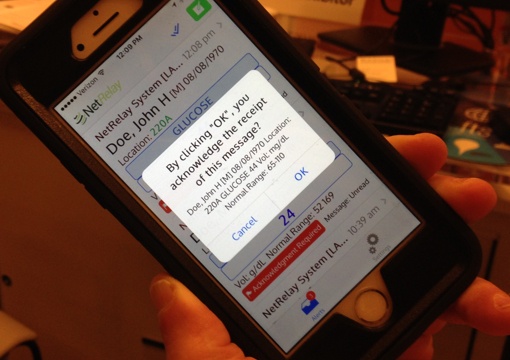Maximize your health care messaging system investment with expert guidance
Health care messaging can effortlessly span the enterprise supporting staff, caregivers, hospitalists and specialists and community physicians, health care trading partners and patients across ambulatory and acute care settings with sophisticated features for security, reliability and workflow automation.What do you want messaging to do?
With more than 200 competitors, the health care messaging vendor landscape is vast and not a little confusing. Here is a list of common messaging use cases; if your use case isn’t listed it may still be available or configurable in systems from one or more vendors.
Alarm notification
Care Management
Clinical Decision Support
Clinical Surveillance
Critical Test Results Management (CTRM)
Emergency / Mass Notification
Medication Management
Patient Engagement
Patient Flow
Population Health Management
Referrals Management
Rounding
Secure Text Messaging
Telemedicine
Workflow Automation

Tim Gee
Principal
Messaging became a focus for me 15 years ago when I first wrote the requirements for an alarm notification system. Since then I have developed requirements for other messaging systems, completing messaging consulting engagements for medical device, health care IT and provider organizations. I have made it my business to cultivate a deep understanding of the technology (how it is built and how it evolves), vendor methods and limitations, and knowledge of provider operations, strengths and limitations. I've been writing about messaging for some time and the blog posts listed below provide examples of some of my knowledge and understanding of messaging applications.
Unlike most other consultants with provider backgrounds, I have sat on both sides of the table — over 25 years with both vendor and health care providers. As a consultant for 10+ years, my focus is workflow automation at the point of care — in both acute care and ambulatory settings. Besides process optimization and governance, the technologies found at the point of care are a big part of my practice.
Health care providers who chose their messaging solutions wisely, will adopt systems that become building blocks to an eventual enterprise messaging architecture.
If not, the acquisition and integration of follow-on messaging solutions will require the costly replacement of previous solutions or result in hard to use and manage messaging app proliferation.
Phases of a Messaging Engagement
Project Plan
Before any consulting project can begin, a detailed project plan or roadmap is needed to clearly define scope and the specific steps to be taken to achieve the goals of the engagement. This is usually a two day process. Project Roadmapping can be broken out as a separate project from the overall engagement, or included as the first phase of an engagement.
Needs Assessment
A thorough needs assessment documents immediate and medium term needs to encompass all potential users and workflows. The assessment considers types and locations of users and their roles, documents use cases and the interfaces, devices and IT infrastructure required.
System Requirements
The needs assessment is transformed into written system requirements detailing the operating volumes and characteristics of the messaging solution. A complete system requirements document ensures that all the required messaging features, user roles and use cases are specified, along with the necessary systems integration, communications devices and IT infrastructure. A roadmap aligns the various product life cycles for the key devices, integrations and infrastructure to years into the future.
Vendor Selection
A Request for Proposal is created based on the needs assessment and system requirements. RFP responses are assessed for conformance to stated requirements in the RFP, and vendors are ranked on how fully they meet system requirements. Selection of one or more vendors of choice is facilitated, and guidance is provided through the vendor demo and site visit phases. The client is responsible for the ultimate awarding of the purchase order.

Take your next step to adopting the best solution for your unique messaging needs.
Avoid these potential pitfalls when adopting messaging solutions
Focusing on product features rather than your needs
Most RFPs focus almost totally on specifying messaging features. Yet, a needs assessment that is incomplete can result in a poor fit between messaging solutions and buyer workflows. This can force users to have to change workflows to accommodate the new product, and maybe forego some workflows altogether.
Only looking at immediate needs
Avoiding user and adoption landmines
Messaging app proliferation
Poor systems-of-systems engineering
Inter-enterprise deployments across health care trading partners
Increase your messaging IQ
The following articles provide some background, analysis and a bit of prognostication on health care messaging.
Most purchases by health care providers are team efforts, but messaging solutions are even more so. Messaging deployments cover a wide set of users in various roles, departments and even separate organizations.
Bringing all these stakeholders together, taking them through an acquisition process and then agreeing on the best overall solution, well, that's a tall order.
As you continue your process to adopt a health care messaging solution, share the resources on this site with your colleagues. When you're ready, schedule your free 30 minute consultation to discuss your situation and next steps.
TAKE YOUR NEXT STEP TO ADOPTING THE BEST SOLUTION FOR YOUR UNIQUE MESSAGING NEEDS.
Don't miss these
- Best Non Gamstop Casinos UK
- Migliori Casino Online
- Migliori Casino Online 2025
- Best Non Gamstop Casinos
- Gambling Sites Not On Gamstop
- Casinos Not On Gamstop
- Casinos Not On Gamstop
- Non Gamstop Casino
- Online Casinos
- Non Gamstop Casino Sites UK
- Non Gamstop Casino UK
- Non Gamstop UK Casinos
- Non Gamstop Casinos UK
- Non Gamstop Casino Sites UK
- UK Casinos Not On Gamstop
- Non Gamstop Casinos
- UK Casinos Not On Gamstop
- Casino En Ligne France
- Casino En Ligne France
- Non Gamstop Casino Sites UK
- Non Gamstop Casino
- Best Non Gamstop Casinos
- I Migliori Casino Non Aams
- Best Non Gamstop Casinos
- Migliori Casino Non Aams
- Meilleur Casino En Ligne Belgique
- Migliori Siti Poker Online Italia
